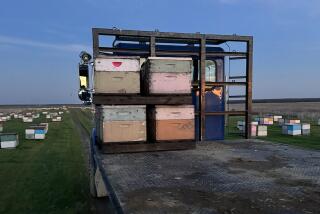‘Killer Bee’ Migration Studied
- Share via
The relentless northward march of so-called “killer bees” may be spearheaded by purebred African queens rather than by those cross-mated with domestic bees as previously thought.
In a pair of studies published in the British journal Nature, teams from the University of Florida and the University of Michigan reported genetic research has indicated the main force behind the bee invasion is from purebred queens.
The scenario conflicts with the theory of Agriculture Department researchers that the trend is being fueled by interbreeding between relatively new swarms of wild African bees and existing colonies of domestic European insects.
The issue has important implications for protecting the U.S. bee industry from destruction--and Americans from stings--because if the bees are readily cross-mating, senior department researcher Thomas Rinderer said, officials may be able to dilute further the notorious aggressiveness of invading African queens by releasing masses of European males, or drones.
Since the first African honey bees were released accidentally in Brazil in 1957, the aggressive strain has spread throughout most of South and Central America at a pace of about 300 miles a year. They are expected to cross into Texas from Mexico by the middle of next year.
More to Read
Sign up for Essential California
The most important California stories and recommendations in your inbox every morning.
You may occasionally receive promotional content from the Los Angeles Times.













